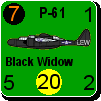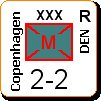Extraneous
Posts: 1810
Joined: 6/14/2008
Status: offline

|
.P These write-ups give a brief history of one or more vessels from each of the
main classes of submarine used by the Royal Navy (RN) during World War II. These
World In Flames counters represent a number of submarines rather than any
specific individual vessel. The dates printed on the back of the counters do not
tie up in any meaningful way with build dates for the various RN submarine
classes and therefore the counter date in most cases should be ignored.
.P During the inter-war years the British tried to get the submarine banned as a
weapon of war. However, without the unanimous agreement of the other major naval
powers, this policy was doomed to failure. Instead therefore, the British
pursued a similar path to that adopted for limiting the size of the surface navy,
i.e. limiting the number of submarines allowed through treaty.
.P The Anglo-German Naval Agreement of 1936 limited the number of submarines that
Germany could build to 100% of the British total, and at the outbreak of World
War II the RN's submarine service, like that of the Kriegsmarine, numbered fifty-
seven boats.
.P Largely as a consequence of the lack of money available for defence spending
during the inter-war years, the British concentrated on building submarines that
used tried and trusted technology. This policy meant that, generally speaking,
RN submarines were more reliable than their foreign contemporaries at the start
of hostilities; German and US submarines suffered initially from unreliable
torpedoes, and many of the Italian and Japanese submarine designs proved
cumbersome to operate - a particular problem when diving.
.P While German submarines were designed to wage war principally against the
merchant shipping that kept the United Kingdom fed and provisioned, their British
equivalents were designed primarily to attack enemy warships. As a consequence,
the British boats featured a larger number of torpedo tubes than their rivals in
order to allow the biggest salvo possible.
.P In actual fact, RN submarines were deployed in all theatres during World War
II, and enjoyed success against enemy warships and merchant vessels alike. RN
submarines were also used extensively on "special forces" operations. More than
seventy boats were lost during the war along with approximately 2,000 officers
and men.
.P This write-up looks at the T-class submarine and specifically HMS Torbay, a
boat from the first of the three T-class groups.
.B Engine(s) output: 2,500 hp (Surfaced) 1,450 hp (Submerged)
.B Top Speed: 15.25 knots (Surfaced) 9 knots (Submerged)
.B Main armament: 10 x 21-inch torpedo tubes, 1 x 4-inch (102mm) gun
.B Displacement (Fully Submerged): 1,595 tons
.B Diving Depth: 300 ft
.P The T-Class submarine was the RN's replacement for the O, P and R-class
boats that, by the mid-thirties, could no longer be considered front line
vessels. The first group, consisting of fifteen vessels, was ordered between 1935
and 1938; the second group of seven boats was ordered in 1939; while the thirty-
one boats of the third group were ordered after the outbreak of the Second World
War, between 1940 and 1942. A total of fifty-three boats would ultimately be
built - the largest number of boats in any single RN class of submarine.
.P The design changes between the three groups were not dramatic, rather the
subsequent classes were logical developments of what had gone before. The initial
group evidenced some teething problems, and one boat - HMS Thetis - was lost in
a pre-war accident. Within each group there were also detail changes from boat to
boat.
.P With enemy warships as the prime target for British submarines, the first
group of the T-class were given an incredible ten, forward mounted, torpedo tubes
in order to increase the probability of securing a hit. These were arranged: six
forward (internal), two forward (external) and two amidships (external). A total
of sixteen torpedoes could be carried. The second and third group boats had an
additional stern mounted torpedo tube and the two amidships tubes were altered to
stern facing. Seventeen torpedoes could be carried and there was also room for up
to twelve mines.
.P The boats were all fitted with a 4-inch forward mounted gun and three machine-
guns were also carried.
.P The boats of the T-class were to provide an excellent addition to the RN's
submarine service during the war, and indeed, continued to make a valuable
contribution well beyond 1945; the last of the T-class was not taken out of
service until 1969.
.P HMS Torbay was commissioned in January 1941 and was placed under the command
of the colourful Lt-Cdr Anthony Miers. Under his brilliant leadership, Torbay was
to make herself a thorough nuisance to the Axis forces in the Mediterranean over
a period of eighteen months. In the process, Miers was to win the Victoria Cross,
the highest award for bravery in the face of the enemy.
.P During her work-up Torbay was in a collision with a merchant vessel, although
she managed to survive that incident without too much damage. Then, when nearing
the end of her work-up at the end of March, she was suddenly ordered at short
notice to the Bay of Biscay. This order was in response to a possible Atlantic
breakout from the port of Brest by the German battlecruisers Scharnhorst and
Gneisenau. The Admiralty ordered a submarine patrol line to counter this threat,
although no breakout was ultimately attempted.
.P With the threat from the German ships abated, Torbay was ordered to sail for
Gibraltar, from where she would begin her first Mediterranean patrol. The patrol
was designed to see her heading in an easterly direction and ultimately end her
journey at Alexandria, Egypt, where she would join the boats of the 1st Submarine
Flotilla.
.P Torbay's next patrol took her into the Aegean Sea where she was quick to get
amongst the enemy. Three caiques, two tankers and one Italian schooner were sunk
before Torbay returned to Alexandria in mid-June.
.P Further success followed on her next patrol, also in the Aegean; the Italian
submarine Jantina, four German sailing vessels, one tanker and three smaller
ships were sunk together with one tanker damaged. However, some have subsequently
tried to pin a war crime charge on Lt-cdr Miers for what happened during an
encounter with one of the German ships; LVI. The writer believes these
accusations to be a total distortion of the facts and simply not worth repeating.
.P Torbay's next patrol took her to the Gulf of Sirte where she met with much
reduced success. Having attacked, and missed, two escorted merchant ships, Torbay
found herself under a heavy and sustained attack from the torpedo boat Partenope.
The submarine was able to get away and, after sinking a small sailing ship,
continued to Crete where, under the cover of darkness, she managed to evacuate
over 100 Allied soldiers.
.P After a refit, Torbay returned to action in September for what was a largely
frustrating patrol. She managed to sink a merchant ship in a Cretan harbour, but
was otherwise unsuccessful despite a number of attacks being launched - and for
which she once more came under heavy fire.
.P Torbay's next patrol saw her back off Libya for another secret mission. In
October, Torbay had landed an advance party who were to reconnoitre the ground
to prepare for Operation Flipper; an attack by special forces against the
headquarters of General Rommel, the commander of the Afrika Korps. The following
month Torbay and her sister boat Talisman were used to land further troops
behind enemy lines for the actual attack. Unfortunately, the plan went very
wrong - not least because Rommel was not even in North Africa at the time - and
the commander of the expedition, Lt-Col Keyes, was killed during the raid.
.P The last month of 1941 saw Torbay back on familiar ground in the Eastern
Mediterranean and Aegean Seas. She sank a number of small sailing vessels as well
as applying the coup de grace to the transport ship Sebastiano Venier that had
previously been damaged by the submarine HMS Porpoise.
.P In January 1942 Torbay undertook another clandestine operation, this time to
land special forces operatives on Crete. The following month she began her tenth
patrol in the Mediterranean, and it was this patrol that was to provide Miers
with opportunity to earn his Victoria Cross. Torbay's patrol area was again centred
on the Eastern Mediterranean. The start of the patrol saw two merchant vessels
sunk and Torbay survive three attacks from Italian escort vessels.
.P Then, on the night of the 4th/5th March, Miers ordered Torbay into the channel
leading to Corfu harbour. Earlier that day Torbay had been frustratingly out of
range of a four-ship convoy that was heading for the harbour. Incredibly, that
night, Miers and his crew had to surface just outside the harbour in order to
re-charge the submarine's batteries. Having done so, without detection, Miers
then chose to enter the harbour where he successfully attacked two ships before
retreating with all possible speed. Torbay was hunted for many hours in the
tight confines of the channel, but once again, his pursuers were to be out of
luck. It was an incredibly audacious attack.
.P In April, Torbay undertook her last patrol before returning to the UK for a
much needed refit. Despite being slightly damaged during an air attack at the
start of the operation, Torbay still managed further success: two German and two
Italian ships meeting their end at the hands of this remarkable submarine and her
equally remarkable commanding officer.
.P For Miers however, this patrol would be his last aboard Torbay. By the time
her refit was complete at the end of 1942, Torbay had a new commander, Lt
Clutterbuck, and a new theatre of operations. Torbay was one of the submarines
that were stationed off Norway to guard against any potential Kriegsmarine
attack on the Arctic convoy JW51B. Torbay failed to come into contact with any
enemy vessels and returned to the UK early in the New Year.
.P After this patrol, Torbay headed back to the more familiar - and warmer -
surroundings of the Mediterranean. She reached Gibraltar at the end of January
and then undertook her first Mediterranean patrol of her 2nd commission in the
Western Mediterranean. At its conclusion, during which she sank a German merchant
ship, Torbay headed for Algiers.
.P 1943 was another busy year for Torbay. Her next patrol began at the end of
February and this time took her to the Gulf of Genoa. She began by despatching
an Italian minesweeper off Corsica and followed this up by sinking two German
merchant ships. Further north a small Italian auxiliary vessel was sunk followed
by a merchant ship, before Torbay bombarded the Italian town of Imperia. She
was back in Algiers at the start of March.
.P Torbay's next patrol saw her operate north of Sicily. There, she successfully
attacked two merchant ships and a fishing vessel before returning to Algiers and
a hotter than expected reception. While moored in the harbour she was damaged
during an air raid on the port. Torbay had to sail for Gibraltar to be properly
repaired, but she was ready to resume service in June and promptly returned to
Algiers.
.P Torbay resumed where she had left off and undertook a further patrol in the
Tyrrehenian Sea; sinking another three Italian ships. She then started her next
patrol from Malta and sank another two ships in the Eastern Mediterranean before
sailing for Beirut. Due to a defect that required repair, Torbay was not ready to
begin her next patrol until mid-October.
.P Torbay undertook five more patrols in the Aegean sea between October 1943 and
February 1944. During these patrols she sank five ships and a floating dock.
However, her final patrol would prove fruitless, and upon its conclusion she was
ordered back to the UK for a refit and to prepare her for service in the Far
East. She arrived in the UK in March 1944 and was ready to sail for Trincomalee,
Ceylon, in December. She also had a new commanding officer in situ - Lt.cdr
Norman. Torbay arrived at her new home in January 1945, whereupon she joined the
4th Submarine Flotilla.
.P For her first patrol in March, Torbay was ordered to assist a special mission on
the Arakan coast; Operation Baboon. In all, Torbay completed five
patrols in the Far East, three of which were used to assist special missions.
However, enemy targets were becoming few and far between in the
Eastern Indian Ocean at that point in the war; Torbay's victims totalled just two
coasters and two junks.
.P Torbay's final war patrol - her 29th - ended on the 24th August 1945. She then
began the long journey back to the UK, where she arrived at the end of October.
.P HMS Torbay was scrapped in 1947.
Caique
1: (slang) a light skiff used on the Bosporus
2: (slang) a Levantine sailing vessel
3: two species of parrots in the genus Pionites
Uboat.net - HMS Torbay
Operations are special missions.
Special Missions Mediterranean:
October 10, 1941 landing Army Captain John Edward Haselden behind enemy lines on the coast of Libya to reconnoiter for a possible operation in conjunction with local Arabs
November 10, 1941 Operation 'Flipper' - Landing commandos behind enemy lines to kill the commander of the Afrika Korps - Erwin Johannes Eugen Rommel.
During the nights of January 12/13, 1942 and January 13/14, 1942 landing eight men and supplies on a beach on the south coast of Crete.
Special Missions Asia:
March 1945 Operation Baboon
April 1945 Two Missions (no details)
May 1945 One Mission (no details)
August 7, 1945 Sepcial operation (no details)
< Message edited by Extraneous -- 12/31/2010 8:46:14 PM >
_____________________________
University of Science Music and Culture (USMC) class of 71 and 72 ~ Extraneous (AKA Mziln)
|
 Printable Version
Printable Version










 Yes he should know the the Norwgian coast - or at least the fjords - like the back of his hand. Do you know how to contact him?
Yes he should know the the Norwgian coast - or at least the fjords - like the back of his hand. Do you know how to contact him?




 Revolvers do not have a magazine that’s why they are called revolvers.
Revolvers do not have a magazine that’s why they are called revolvers. 
 New Messages
New Messages No New Messages
No New Messages Hot Topic w/ New Messages
Hot Topic w/ New Messages Hot Topic w/o New Messages
Hot Topic w/o New Messages Locked w/ New Messages
Locked w/ New Messages Locked w/o New Messages
Locked w/o New Messages Post New Thread
Post New Thread